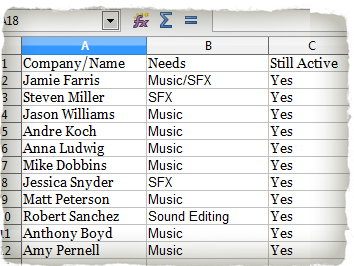
I’ve been having a little success with my new client base that I acquired during my Music Licensing Case Study. If this is your 1st time visiting my site or if you’re clueless as to what I’m talking about, you can catch up by reading this post. It goes over my process of getting 200+ new clients, basically handed to me if you will.
I was excited because new clients + new projects = more income. I had a gut feeling that most of these prospects would either be out of the game or tied up with life. Filtering would have to be done to separate real potential clients from those who would clog up my contact list.
“There were 361 Clients to be exact”
The Filtration Process
I’ve already been introduced to these clients by the music library(s). Well, their assistants, but same difference. What’s great about that is there’s also a sense of ‘trust’ that’s passed along as well – So I didn’t have to sell myself.
The only thing left to do was inquire about projects and whether or not there was room for another contributor (me) to supply sound.
Initial Contact With Clients
I did most of this via email very few via phone. Email was faster because I sent everyone the same email based from a template. I did modify the template to make the emails more personable. You never want to send canned emails, they leave a bad taste in the mouths of your clients (potential clients). I can’t stand when a company sends me canned emails, pisses me off. You want my business? Make the email personable.
[private] Here’s my Email template
Coming Soon[/private]
I put everything into a spread sheet: Name, company, contact information, type of projects they generally work on, what type of music and sound they generally need and whether or not they were still working in the industry. This made it easy to revert back to in the future. Kind of like a rolodex? Yea one of those, but obviously more detailed 🙂
Client Response Time
I wanted to wait until everyone replied before sharing this update. In total, it took roughly 3 months for everyone to get back with me. I got everything from “we have an in-house production staff” and “We’re booked for the year” to “we’re not currently working in the field” and “thanks for contacting us, how much do you charge”
not in those exact words, but you get the gist.
The End Result
In the end, after all the emailing and rounds of phone tag, I wound up with 143 client who were still active. Out of those, 37 were currently working on projects and 9 needed assistance with sound. Not too shabby right? I mean, that’s 9 projects I didn’t have before. 3 of those projects were up font pay. I mentioned a little blurb about this which can be found here.
The goal is to eventually build a big enough client base to supply me with (small) projects every quarter. This is going to require me to constantly revisit and tweak this list. Why small projects? Eh, they are easier to manage, easier to find and generally don’t last very long.
Big projects pay well, but are harder to land. I’d much rather have smaller consistent projects because at the very least, they’ll generate an income until I’m able to land something bigger. “A bird in the hand is better than 2 in the bush”, never thought I’d use that phrase.
This is all from 1 library, I haven’t even begun to pry into the others yet, but I do have the info/contacts logged
Please Share Your Process
How are you tracking clients? Do you use a spreadsheet or any other type of management tools? If so, I’d love to hear about them.


Very interesting article, making a spreadsheet is a good way to keep all your contacts nice and organized, so using them is a great way to speed things up.
I find myself using spreadsheets too less since I’m used to making it in a text file, and sometimes I think why haven’t I just made a spreadsheet from this right away? Since within a spreadsheet you can order your data, easily filter the different contacts, etc.
Thanks for the article!
Hey ArtFx, thanks for the kind words. Spreadsheets are the only way I can keep things in order otherwise I’m just everywhere. I started with text files to lol. Now it’s spreadsheets and color codes.
When you say they needed assistance with sound, what do you mean?
Damond,
“sound” meaning: Music, editing, mixing, vo etc. Just easier to say “sound” vs naming off 10 different things
I keep all my music contacts in a Google Docs spreadsheet, and with each contact I note the company name, position held, where I met them and when I last contacted them. I can’t stress enough the importance of having this list. I frequently refer to it for reasons I never thought I would, for example recently a co-writer I work with mentioned he’d be interested in producing an R&B female vocalist but was frustrated by the fact that he didn’t know any good vocalists. I spent a minute looking at my list and found him one. In another instance, a band leader needed a bassist last minute and although that’s not the instrument I play, I have many bass players in my contact list and was able to help him. Even if you aren’t being paid in cases like this, you become known as a good source/reference and you’re creating good karma which will eventually pay dividends.
Greg – how do you deal with clients that offer smaller projects that don’t necessarily fit the type of work you want to do? Do you subcontract these jobs or do you tell the client you’d like to take a pass on it but would of course like to be kept in mind for future projects? There’s an obvious risk in the latter approach.